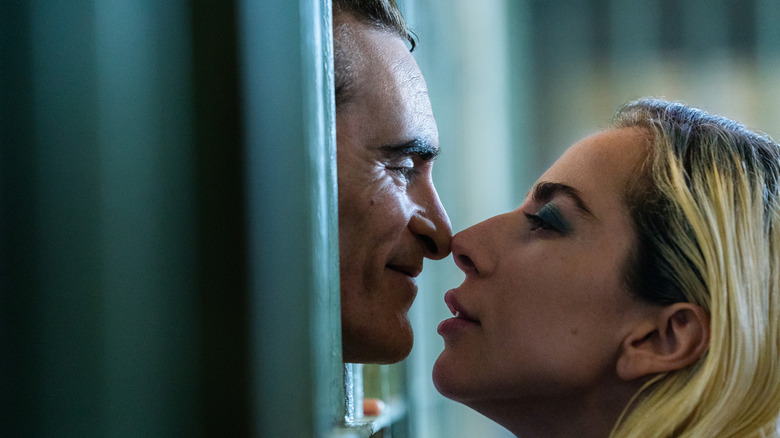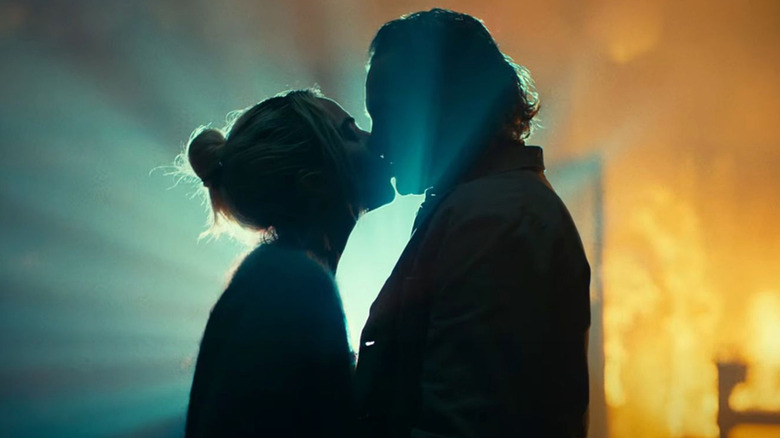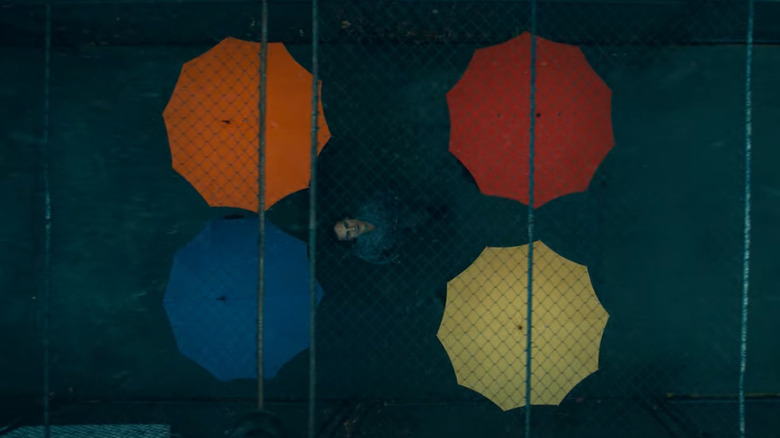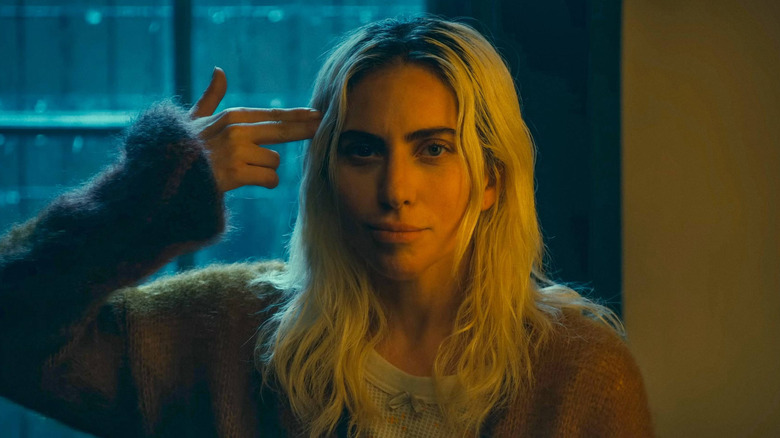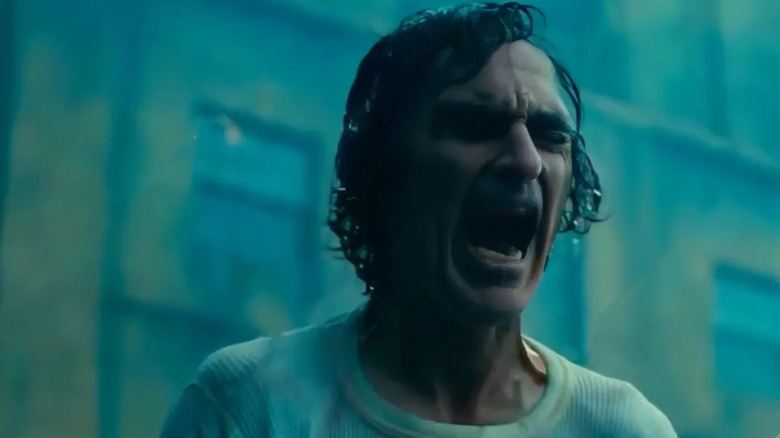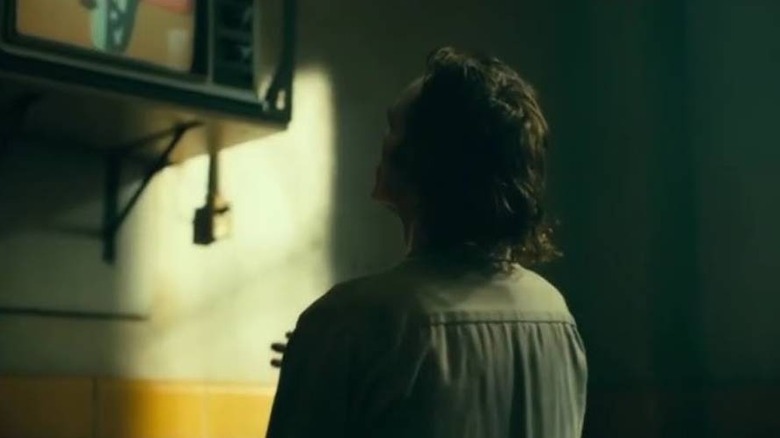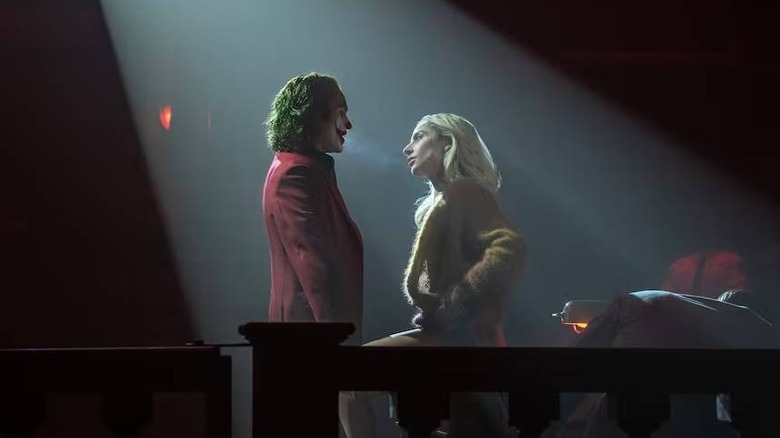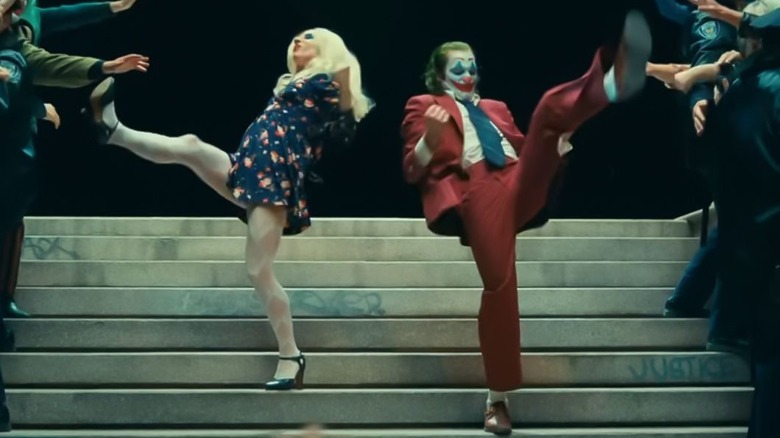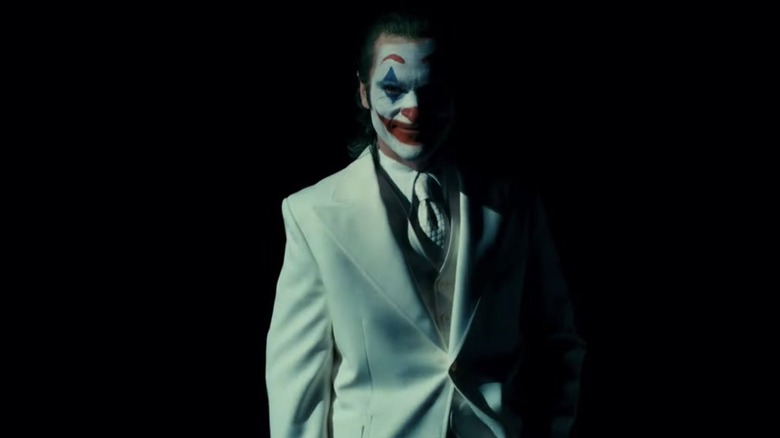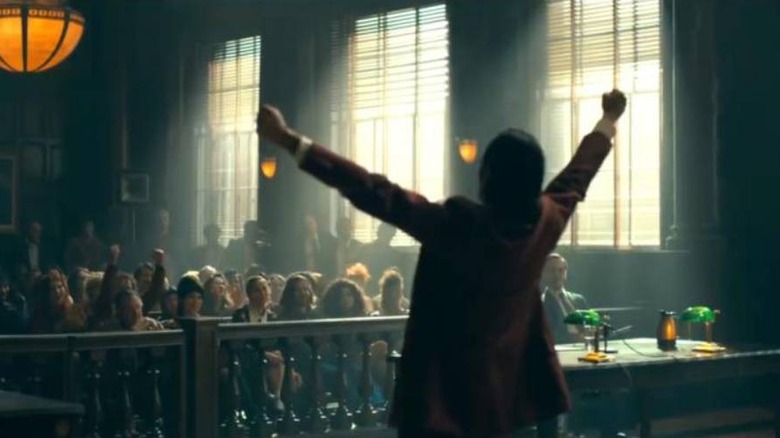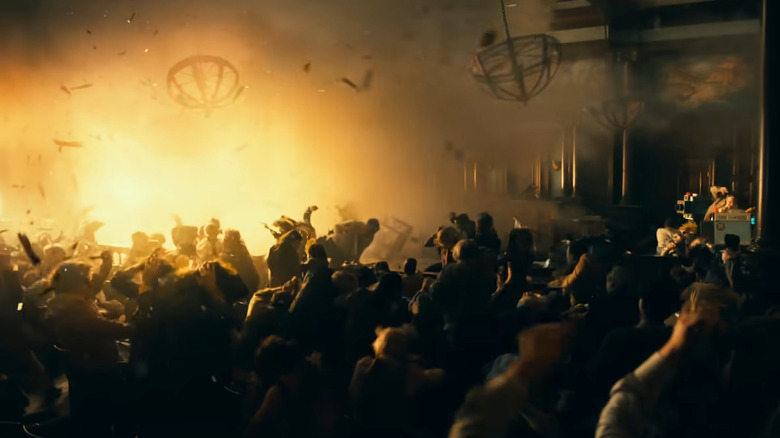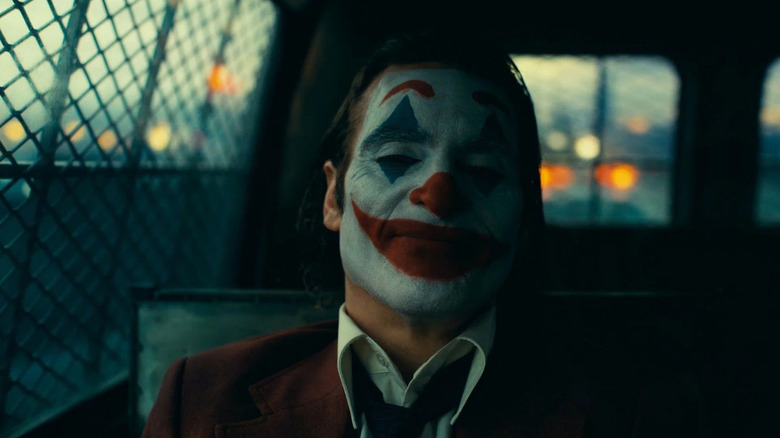Small Details You Missed In Joker: Folie A Deux
Contains spoilers for "Joker: Folie à Deux"
2019's "Joker" hit the world like a hurricane, grossing over $1 billion at the box office and earning 11 Oscar nominations, with Joaquin Phoenix winning best actor for his portrayal of Arthur Fleck, who dons the Joker moniker. Before the movie even came out, there were concerns it could inspire real-world violence. Of course, that never came to pass, but either way, the movie became a cultural sensation.
Five years later, we now have "Joker: Folie à Deux" to continue Arthur's story. Director Todd Phillips said previously he'd agree to return for the sequel under one condition — if it had the same thematic resonance as the first film. The movie does explore many intriguing themes, such as loving someone for who they pretend to be, rather than who they are. But it seems audiences are responding differently to the sequel than they did to the original. First reactions for "Joker: Folie à Deux" all suggest the same thing — that the movie is a major letdown, even to those who enjoyed the first film.
Regardless of one's thoughts or whether we wind up getting "Joker 3" now, there are plenty of hidden details to scour "Joker: Folie à Deux" for. There are even Easter eggs for fans of classic musicals, which is appropriate given the many musical numbers throughout the film. Regardless of its actual execution, it would appear this movie has plenty on its mind it wanted to convey.
Me and My Shadow
One of the more delightful aspects of "Joker: Folie à Deux" is how it opens with a "Looney Tunes"-style short. It depicts Arthur coming in to host a late night talk show, but his literal shadow has other ideas, tossing him aside so that it can host the show. The cartoon plays into the film's central idea that there could be two personalities within Arthur Fleck — Arthur himself and the Joker persona. Arthur's shadow (his "Joker" identity) is by far the more charismatic of the two, with Arthur having to push back against it. But it's also interesting to consider the name of the short — "Me and My Shadow."
This is the name of a 1927 song, co-written by Al Jolson, that's been covered numerous times over the years by everybody from Frank Sinatra and Sammy Davis Jr. to Judy Garland. Given the many musical influences of "Joker 2," it only seems appropriate for the opening cartoon to have some musical allusions, too.
However, the idea of a "shadow" could have a different connotation in this context. While there's no Batman in "Joker: Folie à Deux," the "Shadow" could be alluding to the Caped Crusader, considering how an early inspiration for the character was the pulp hero The Shadow. This was a mysterious vigilante created in 1931 who appeared in serials, video games, and feature-length movies. Batman clearly overtook the character in terms of popularity, but he may not have existed in the first place if it wasn't for the Shadow.
Colorful umbrellas everywhere
"Joker: Folie à Deux" establishes early on that Arthur Fleck still very much experiences breaks from reality. This is emphasized in one scene where he's escorted by four Arkham Asylum guards. In one shot, they all have black umbrellas. However, when Arthur looks up, the umbrellas are now red, orange, blue, and yellow. He'll experience similar fanciful delusions throughout the film, including his various musical numbers with Harleen "Lee" Quinzel (Lady Gaga).
The inclusion of the colorful umbrellas is a nod to a similar shot found in the 1964 French musical, "The Umbrellas of Cherbourg." That movie, in which all the dialogue is sung, has served as an inspiration for many modern films, including "La La Land" and "Barbie." "Joker: Folie à Deux" can be added to that list, and there may be even deeper significance with the allusions to this particular film.
"The Umbrellas of Cherbourg" is a tale of first love, but the two lovers are ultimately torn apart by circumstance, as Guy Foucher (Nino Castelnuovo) is drafted into the Algerian War. "Joker 2" is also ultimately a tale of love, as Arthur falls for Lee, but their relationship deteriorates not from war but from Arthur's admission that there's no Joker identity at all: it's just him that killed TV host Murray Franklin (Robert de Niro), with the Joker never having existed at all.
Lee mimics Arthur
The origin story of Harley Quinn and Joker's relationship is that she's his psychiatrist and falls in love with him. "Joker: Folie à Deux" breaks from traditional canon since when they first meet, she's also a patient, although we later learn that she in Arkham voluntarily. Lee is basically a huge fangirl of the Joker and wants to meet him. They first connect when Lee gets Arthur's attention outside of the music room and puts her hand in the shape of a gun to her temple. This is the same motion Arthur did when he broke into Sophie's (Zazie Beetz) apartment in the first film.
This action will have greater significance later on, when Lee becomes disillusioned after Arthur admits the Joker was never real. She puts an actual gun to her temple but later sees Arthur on the iconic steps where he danced in 2019's "Joker," so it's clear that she doesn't pull the trigger.
From the gun motion with her finger to the staircase, it's clear that Lee knows a lot about Arthur. Or to be more accurate, she knows a lot about the supposed Joker persona he renounces during his trial, when he says he was fully aware of his actions from the first film.
Joker's a bit of a Psycho
Even if Arthur doesn't have a split personality, he's clearly a deranged individual, likely due to his childhood trauma. And "Joker 2" has a couple of references comparing Arthur to another deranged movie character — Norman Bates (Anthony Perkins) from "Psycho."
Early in the film, Arthur attends an interview to strengthen the case that he has dissociative identity disorder (DID). While speaking with Dr. Beatty (June Carryl), he mimics his mother's voice. In "Psycho," Norman Bates has DID and develops an entire alternate personality based on his mother, Norma. When this personality takes over, Norman mimics her voice, talking like an older woman.
During the trial in "Joker: Folie à Deux," Sophie takes the stand and mentions having conversations with Penny Fleck (Frances Conroy), Arthur's mother. Sophie recalls Penny saying that Arthur was harmless and wouldn't hurt a fly. This is a nod to the famous final line of "Psycho," when Norman says in his mother's voice: "I'm not even going to swat that fly. I hope they are watching. They'll see. They'll see and they'll know, and they'll say, 'Why, she wouldn't even harm a fly.'" The irony is that both Norman and Arthur's "weaker" personas hide their actual murderous tendencies.
Pepé Le Pew pops up
"Looney Tunes" factors consistently throughout "Joker: Folie à Deux" beyond the initial opening sequence. During the trial, Arthur yells, "That's all folks," a nod to Porky Pig's famous catchphrase. And there are a couple of scenes where the Arkham inmates are watching Pepé Le Pew cartoons on the TV. The fact that Pepé is the Looney Tunes character being used is interesting, considering he was cut from "Space Jam: A New Legacy" for being problematic. However, his inclusion in "Joker 2" makes a great deal of sense.
Pepé Le Pew's whole deal is that he's constantly pursuing true love even though everyone runs away from him due to his skunk odor. His behavior often borders on stalking and worse, since he still pursues female animals even after they've made their disinterest known. But this could be seen as a stand-in for Arthur's quest in "Joker: Folie à Deux" to find love. Lee shows him attention and genuine affection, and he falls in love with her, hallucinating these romantic musical sequences of the two being together and even getting married.
Once Arthur denounces the Joker persona, Lee exits the courtroom with disdain in her eyes. He tries to get her back, but she's no longer interested. This could be seen as akin to one of Pepé's classic failed pursuits, trying to get a woman interested in him when all she wants to do at this point is get away.
Tiny Joker's on the way (but probably not)
We learn that Lee initially lies to Arthur about various aspects of her upbringing, like how she voluntarily put herself in Arkham and how her father is still alive. Lee eventually admits to deceiving him, but she still manages to get Arthur on her side by revealing she's pregnant after they have a tryst while Arthur is in solitary confinement.
This isn't the first time a DC project has toyed with the idea of Joker becoming a father. The "Batman: Arkham City" video game has a scene where Batman finds a positive pregnancy test from Harley; however, he later finds many negative tests, showing that she wasn't pregnant to begin with. Harley also gets pregnant in the "Batman: White Knight" universe, while in the "Injustice: Gods Among Us" continuity, Harley gives birth to a daughter.
But while other media have dabbled with the Clown Prince of Crime becoming a father, in "Joker: Folie à Deux," it may simply be another lie from Lee. When they meet on the staircase toward the film's ending, it's implied that Lee likely lied about being pregnant, just like how she lied earlier to get Arthur to like her. Within the "Joker" movies, the lines between what's true and what's a ruse are easily blurred.
Some trailer moments didn't make it into Joker: Folie à Deux
Trailers for Hollywood movies don't always accurately reflect the finished product. Many iconic lines from trailers don't wind up in the films themselves, which can cause issues with audience members who feel like they've been duped. For "Joker: Folie à Deux," a major set piece from the trailers is nowhere to be found in the theatrical release (although there's always hope we'll see it in action for the home release).
One of the most iconic moments from 2019's "Joker" is when Arthur Fleck dances down a staircase. Alluding to that, the "Joker 2" trailers depict a scene where Arthur, in full Joker regalia, and Lee, in a blue dress, dance down the courthouse steps with onlookers on both sides. While it seems like this is part of a fantastical musical sequence, it doesn't appear in the movie at all. It also appears that a few other scenes glimpsed in trailers and behind-the-scenes images were left on the cutting room floor, leading many on social media to demand that Warner Bros. release the "Gaga Cut."
On X (formerly Twitter), @stevenartpop posted several Lady Gaga stills not in the movie while writing, "['Joker: Folie à Deux'] would have been a 10/10 had these scenes been kept." Lady Gaga's Lee does have a more muted presence in the film compared to one might ascertain from the promotional materials, which essentially put her character on equal footing with Arthur Fleck. More was clearly filmed with her, but for one reason or another, those scenes no longer appear in the finished movie.
Spiffy suits can only mean one thing -- death
Once Arthur decides to represent himself in court, he dons the spiffy red suit he wore to murder the titular talk show host on "Live! With Murray Franklin." However, he soon wears another get-up that should also be recognizable to comic book fans.
During a fantastical musical sequence where Arthur marries Lee, he's seen wearing a slick white suit. It looks awfully similar to the outfit Joker wears in "The Dark Knight Returns," by Frank Miller, Klaus Janson and Lynn Varley. In that classic comic book story, Joker goes on a talk show where he murders everyone in attendance using his toxin. In either case, it's consistently a bad idea to let Joker dress up and appear on a talk show regardless of the medium.
It's possible the white suit even foreshadows later plot developments. Joker breaks his own neck after Batman refuses to kill him yet again during their big confrontation in "The Dark Knight Returns." Arthur meets a similarly violent end at the hands of another inmate by the end of "Joker: Folie à Deux." In either case, it's consistently a bad idea to let Joker wear a suit and/or go on a talk show, regardless of the medium.
Arthur takes cues from Ted Bundy
About halfway through "Joker 2," Arthur fires Maryanne Stewart (Catherine Keener) as his legal counsel and decides to represent himself. It seems like a move that exists for Arthur to let his Joker persona shine, but a prolific killer actually did the same thing in real life.
Notorious serial killer Ted Bundy represented himself in court because he believed his counsel wasn't able to mount a good enough defense for the numerous murders he committed. Of course, Bundy's action would be all for naught, as he was still found guilty and sentenced to multiple death sentences. "Joker: Folie à Deux" draws several parallels between Arthur and Bundy. A big deal is made early in the film how Arthur's trial will be the first ever to be televised. In real life, Ted Bundy's trial was the first to be televised nationally.
Whereas Bundy serves as the main serial killer inspiration for "Joker: Folie à Deux," the first "Joker" took more inspiration from John Wayne Gacy. Joker's makeup seems inspired by the makeup Gacy wore as a party clown. Additionally, the comedy club Arthur performs at in that film is called Pogo's, while Gacy performed as Pogo the Clown.
Harvey Dent becomes Two-Face ... kind of
If Harvey Dent shows up in any DC-related project, it's a safe bet that he's going to lose half of his face at some point to signal his transformation into the iconic Two-Face. In "Joker: Folie à Deux," Harvey (Harry Lawtey) is the district attorney representing Gotham City in the trial. During the film's climax, an explosion occurs in the courtroom, seemingly injuring and/or killing many. We get a brief glimpse of Harvey on the floor, and while it's hard to make out, it does seem as though half of his face took some damage. Much like how Bruce Wayne's (Dante Pereira-Olson) parents are killed at the end of 2019's "Joker," this is another key moment from the Batman mythos involving one of his seminal villains.
Since Harvey's face definitely isn't as damaged as it usually is in other iterations, this seems to be in line with the more grounded, realistic depiction of Gotham's history that the "Joker" movies have opted for. Plus it's unlikely that there will even be a "Joker 3" in which a new version of Two-Face could come to life. Todd Phillips has said that if "Joker 3" does somehow happen, he won't be behind it. And a threequel would be tough to pull off regardless, considering that Arthur gets stabbed to death in the controversial ending of "Joker: Folie à Deux."
A new Joker rises
"Joker: Folie à Deux" ends with Arthur being told he has a visitor, but we never find out who it is, as Arthur is stopped in the hallway by another Arkham inmate. This man tells Arthur a joke about a psychopath meeting a clown in a bar before shanking him repeatedly in the stomach, resulting in Arthur dying on the floor. As Arthur dies in the foreground, we can make out the other man, who's nameless, laughing maniacally in the background, as he takes his shiv and carves a smile into his own face — similar to the scars Heath Ledger's Joker sported in "The Dark Knight."
So the film ends with Arthur's death, seemingly bringing an end to the Joker ... or at least this iteration. The other man appears destined to become the more comic book-accurate interpretation of the villain, and this is actually something Todd Phillips has hinted at since the first "Joker" movie came out. When speaking about that film's ending to The Los Angeles Times, Phillips explained, "Maybe Joaquin's character inspired the Joker. You don't really know. His last line in the movie is, 'You wouldn't get it.'"
The ending of "Joker 2" also seems similar to that of "The Killing Joke" from Alan Moore and Brian Bolland. That story ends with Joker telling Batman a joke, and it's long been a fan theory that Batman kills Joker afterward as they both laugh. There's little ambiguity about the ending of "Joker: Folie à Deux," and it definitely makes the prospect of "Joker 3" all the more unlikely — unless we're now going to follow Arthur's killer as a new Clown Prince of Crime.
